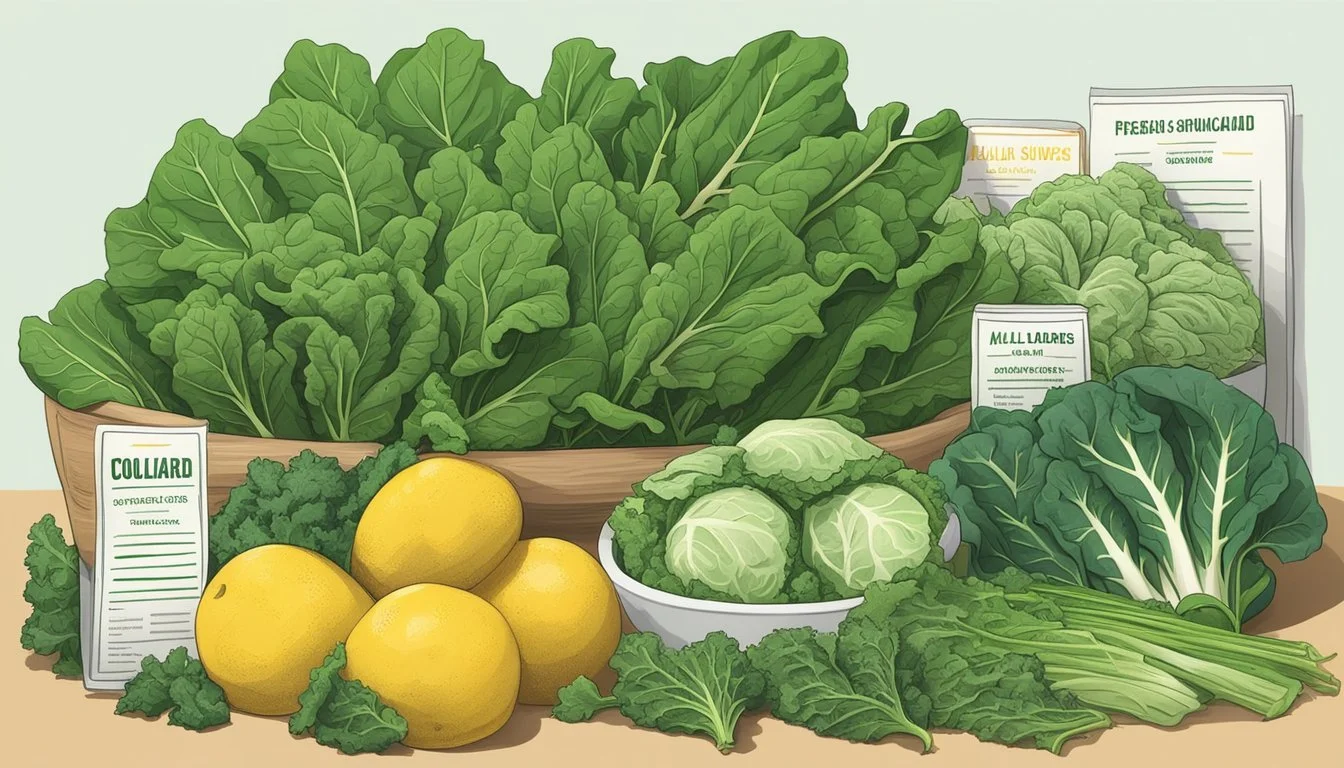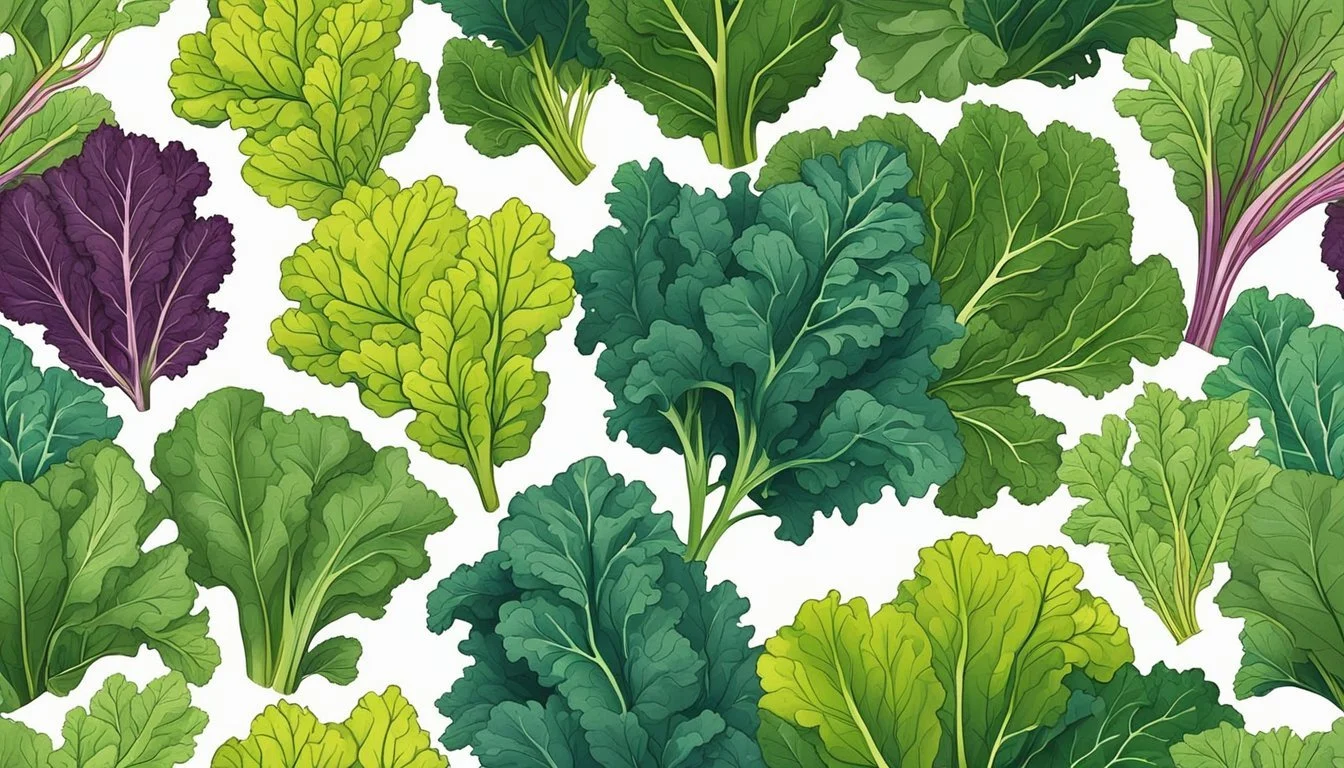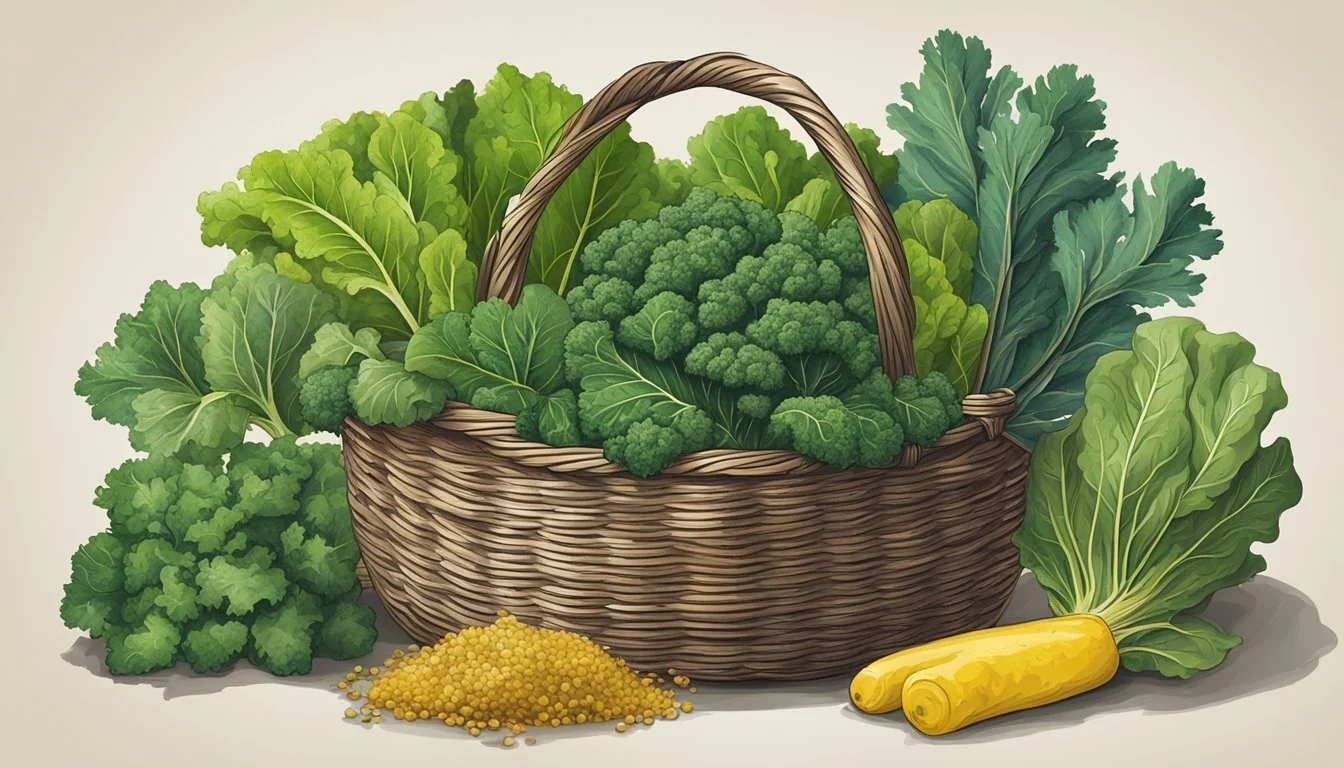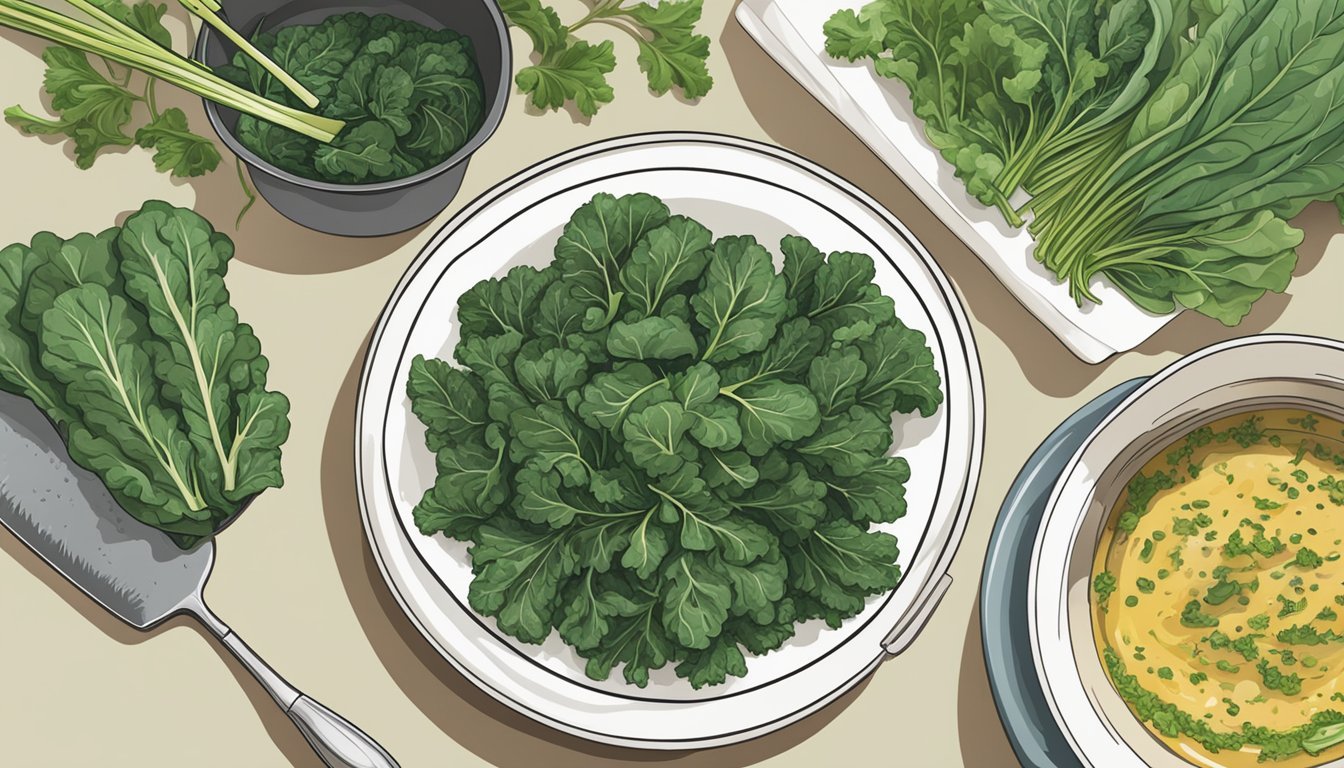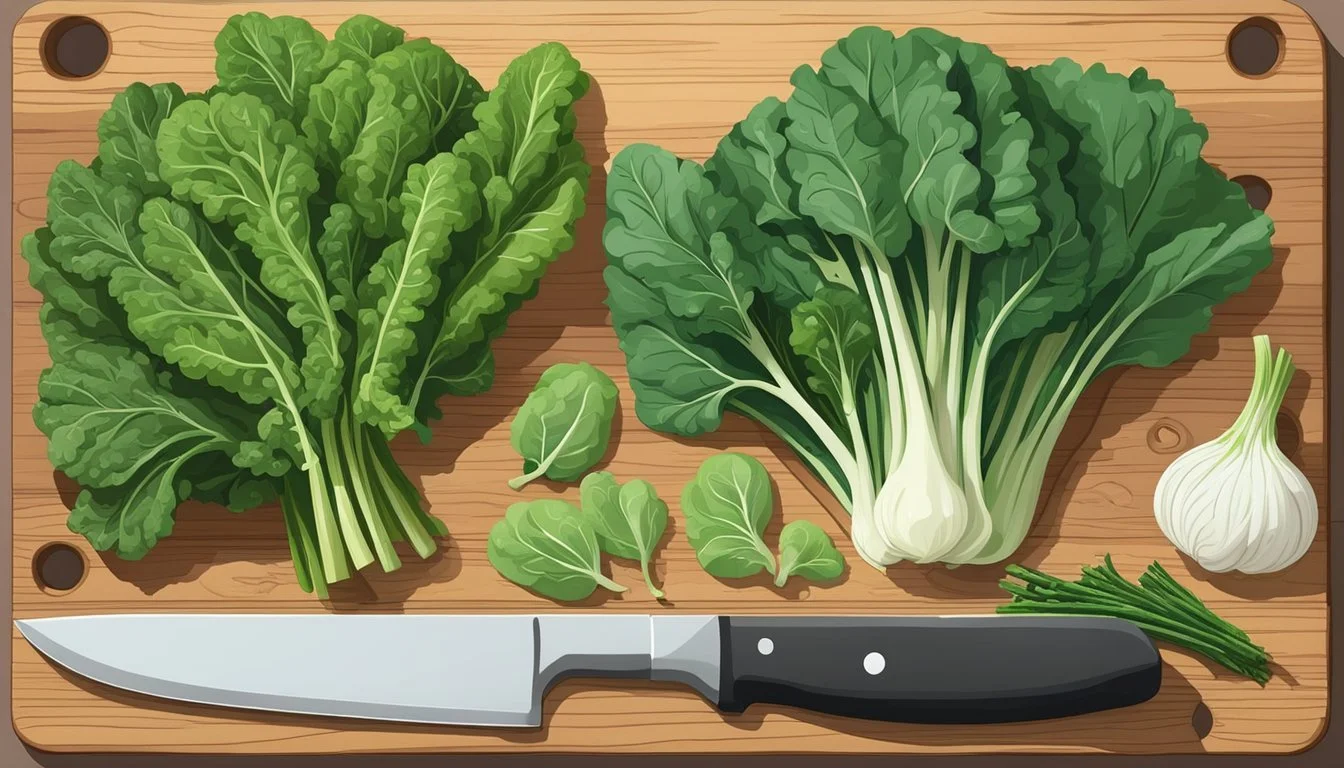Collard Greens Substitutes
Top Alternatives for Your Recipes
Collard greens are a leafy green vegetable that are commonly used in various cuisines, particularly in the southern United States where they are considered a staple. Known for their large, dark leaves and slightly bitter taste, collard greens are also valued for their nutritional benefits. They are rich in vitamins, minerals, and fiber, making them a beneficial addition to any diet.
Finding a substitute for collard greens in a recipe might be necessary when they are not available or when one desires to explore different flavors and textures. There are several alternatives that can provide similar nutritional value and can be prepared in much the same way as collard greens. Among these alternatives, kale stands out as a close relative in the Brassica family, sharing many similarities in both taste and nutritional profile.
When selecting a substitute for collard greens, it is important to consider how the vegetable will be used in a recipe, whether it is in a raw salad or cooked dish. Different substitutes may offer varied levels of bitterness, leafy textures, and cooking times. For those looking to maintain the traditional qualities of collard greens in their dishes, choosing an appropriate substitute can ensure the dish remains both flavorful and nutritious.
Nutritional Profile of Collard Greens
Collard greens are a nutrient-rich vegetable, offering a robust profile of vitamins, minerals, fiber, and antioxidants. These leafy greens are particularly known for their high content of essential nutrients that support overall health.
Vitamins and Minerals
Collard greens are an excellent source of vitamins A, C, and K.
Vitamin A: Essential for vision, the immune system, and reproduction. It also helps organs like the heart and kidneys function properly.
Vitamin C: Important for the growth and repair of tissues throughout the body, and it acts as an antioxidant.
Vitamin K: Crucial for blood clotting and bone health.
In terms of minerals, collard greens provide essential ones such as calcium and iron.
Calcium: Important for bone health and maintaining the necessary level for heart, muscle, and nerve functions.
Iron: Plays a key role in creating red blood cells and transporting oxygen in the body.
Fiber and Antioxidants
Collard greens contain a significant amount of dietary fiber.
Dietary Fiber: It aids in digestion, helps maintain blood sugar levels, and can contribute to lowering cholesterol.
The leafy vegetable is also rich in antioxidants which help combat oxidative stress in the body.
Antioxidants: They protect the body from free radicals, which can lead to chronic diseases if not neutralized.
Best Substitutes for Collard Greens
When collard greens are unavailable or when variety is desired, several leafy vegetables make excellent substitutes. Each alternative brings its unique texture and flavor profile to dishes, while offering nutritional benefits.
Kale as a Substitute
Kale, a leafy green from the Brassica oleracea family, is a nutritional powerhouse with a slightly bitter flavor. It's a versatile kale substitute that can be used in both raw and cooked forms. Kale stands out for its rich nutrient content and its ability to hold up well in cooking, making it a top pick for replacing collard greens.
Substituting with Swiss Chard
Swiss chard has an earthy flavor with a hint of bitterness and can be a flavorful alternative to collard greens. It is known for its vibrant colored stems and mild flavor, which becomes more pronounced when cooked. Swiss chard's tender leaves may require less cooking time than collard greens.
Mustard Greens and Their Use
Mustard greens, with their peppery taste and slightly bitter flavor, are another choice when looking for a collard green substitute. They add a spicy component to dishes and can be an excellent way to vary the flavors in recipes traditionally using collard greens.
Using Spinach as an Alternative
Spinach offers a mild flavor and delicate texture, making it a suitable kale substitute in salads and lightly cooked dishes. Due to its tender leaves, it should be added towards the end of the cooking process to prevent over-wilting.
Exploring Asian Greens
Asian greens, like Chinese broccoli, provide a slightly bitter flavor akin to that of collard greens. These greens are an excellent addition to stir-fries and steamed dishes, imparting an earthy flavor and a boost of nutrition.
Turnip Greens in Recipes
The leaves of the turnip plant, turnip greens have a bitter flavor and are commonly used in Southern cuisine. They can stand in for collard greens in cooked dishes and bring a distinct, stronger taste to the table, along with a rich nutrient profile.
Beet Greens and Watercress Options
Beet greens, with their sweet taste and tender texture, offer a fantastic alternative, especially in sautéed or steamed recipes. Watercress, recognized for its peppery taste, serves as a bold substitute in both raw and lightly cooked dishes, suitable for those looking to replace collards with a bit more bite.
Textural Considerations for Substitutes
When selecting substitutes for collard greens, it's important to consider how the texture of different greens behaves under various culinary applications, especially when cooked and in salads.
Cooked Texture Comparisons
Cooked greens often soften, but different substitutes maintain distinct textures.
Kale: Holds firmness well, providing a robust texture that rivals cooked collard greens.
Spinach: Spinach becomes more delicate and wilts to a tender texture much faster than collard greens.
Raw Salad Textures
In raw salads, the texture of the green is paramount to the dish's overall eating quality.
Kale: Even raw, kale retains a green crunch, although it's slightly less sturdy than raw collard greens.
Baby Spinach: Offers a tender leafy bite, which makes it a softer contrast to the usually tough texture of collard greens in a raw state.
Flavor Profiles in Collard Green Substitutes
When substituting for collard greens, it's essential to understand the flavor profiles of the alternatives to achieve a similar taste in dishes. The following section explores the various flavor dimensions these substitutes offer.
Matching Bitterness
Collard greens are known for their bitter flavor, which is appreciated in many dishes. Kale, a close relative in the Brassica family, has a similar bitter taste, making it an excellent substitute that maintains the characteristic bitterness of collard greens. It's versatile and can be used raw or cooked, closely mirroring collard greens in texture and flavor.
Finding Less Bitter Options
For those seeking milder options, cabbage presents a less bitter choice. Its sweetness, coupled with a mild earthiness, offers a softer flavor profile while providing a similar textural experience. When cooked, cabbage's sweetness becomes more pronounced, making it a suitable substitute for dishes where a less bitter taste is desirable.
Options for Sweet or Spicy Flavors
If one seeks to introduce a sweet taste or spicy notes to their dish, certain greens can provide these flavors as a counterpoint to collards. Spinach has a mild sweetness and tender texture, which can enhance the dish without the signature bitterness. Additionally, mustard greens can be considered when a spicy kick is preferred; they contribute a peppery taste that can stand in for collard greens' robust flavor in some recipes.
Earthy and Peppery Notes
Substitutes that embody earthy flavors or a peppery taste can be impactful alternatives to collard greens. Different varieties of chard, such as Swiss chard, possess earthy undertones along with a slight bitterness, balancing out the strong flavors found in many collard green dishes. Arugula, while not a direct substitute in texture, brings peppery notes that can be incorporated in salads and lightly cooked preparations for a similar boldness.
Substitutes in Common Collard Green Dishes
Replacing collard greens in dishes depends on the cooking method and desired flavor profile. Appropriate substitutes retain similar texture and can withstand similar cooking times.
Substitutions in Soups
In soups, kale stands as an excellent alternative to collard greens due to its durability and nutrient profile. Kale can complement ingredients traditionally paired with collard greens like ham hocks and beans, offering a slightly different but equally hearty flavor.
Alternatives for Stews and Casseroles
For stews and casseroles, one can substitute collard greens with cabbage, which offers a sweeter taste and tender texture. When cooked, cabbage pairs well with the robust flavors of stews and integrates well into the layered textures of casseroles.
Leafy Greens in Stir-Fries
When preparing stir-fries, bok choy provides a crunchy and nutritious substitute for collard greens. It cooks quickly while retaining a crisp texture, making it ideal for high-heat stir-fry methods.
Substitutes in Southern Cuisine
In Southern cuisine, mustard greens can replace collard greens for a spicier kick. They can be sautéed with traditional Southern seasonings and work well as a side dish, complementing recipes that typically feature collard greens.
Regional Availability and Seasonal Substitutes
When seeking alternatives to collard greens, it's essential to consider regional produce availability and seasonal changes as they dramatically affect what's accessible. This can guide cooks to fresh, locally sourced substitutes for collard greens that maintain the intended flavor profile and nutritional value of the dishes.
Substitutes Available in Asia
In Asia, bok choy and gai lan (Chinese broccoli) are excellent regional substitutes for collard greens. Bok choy, with its mild and slightly sweet flavor, is readily available across the continent and can be found both fresh and frozen. Gai lan, known for its slightly bitter taste and similar texture to collard greens, is commonly used in Asian cuisine and widely accessible in local markets.
Greens from the Mediterranean Region
The Mediterranean region offers a variety of leafy greens that can replace collard greens. Swiss chard, a close relative with a similar robust texture, thrives in this climate. Both the green and red varieties of Swiss chard are common in local markets, and their wide availability makes them a convenient substitute. Beet greens, the leafy tops of beetroots, are also prevalent and can be utilized in the same way as collard greens for a nutritious alternative.
Local Options in Various Seasons
The availability of collard green substitutes in any region can shift based on the time of year due to seasonal growing cycles. In spring, mustard greens emerge as a fresh option, with a peppery kick that mellows upon cooking. During summer, kale becomes abundant, providing a slightly bitter but nutrient-rich alternative. As autumn approaches, turnip greens come into season, offering a spicy yet suitable replacement. In the cooler months, look for spinach, which can easily be found fresh or frozen and offers a more delicate texture as well as flavor when compared to collard greens.
Health Concerns and Dietary Considerations
Selecting an alternative to collard greens involves considering both nutritional profiles and health impacts. This section examines low-calorie options, cooking methods for optimal nutrient retention, and allergy considerations.
Low-Calorie Options
Leafy greens are generally low in calories and are a nutritious part of a balanced diet. Kale and spinach stand out as excellent substitutes for collard greens when one is looking to maintain a low-calorie diet. They provide essential vitamins and minerals without a high-calorie count.
Kale: Rich in vitamins A, K, and C, as well as minerals like potassium and calcium.
Spinach: Provides iron, magnesium, and folate, alongside vitamins A and C.
Cooking Methods and Nutrient Retention
The method of cooking leafy vegetables is crucial for preserving their nutritional value. For instance, steaming or sautéing can maintain more nutrients than boiling. Nutrient loss can occur with prolonged cooking times, so it is recommended to cook these greens until just wilted to maximize their health benefits.
Steaming: Preserves most nutrients and antioxidants.
Sautéing: Quick heat exposure retains vitamins and minerals.
Considerations for Food Allergies
Food allergies play a significant role in choosing appropriate substitutes. It's essential to note that kale, spinach, and other leafy greens are not common allergens, but they could be problematic for individuals with specific food sensitivities. Always check for potential food allergy interactions, especially when consuming new vegetables or when serving guests.
Allergens: Rare among leafy greens, but individual sensitivities may exist.
Cross-Reactivity: Some individuals with pollen allergies might experience cross-reactivity with certain vegetables.
Preparing and Cooking with Substitutes
When substituting for collard greens in recipes, it's important to consider the characteristics of alternative greens. Each substitute has its own preparation methods and ideal cooking times to best mimic the robustness of collard greens.
Preparation Methods for Different Greens
Kale: This hearty green should be rinsed thoroughly and the stems removed before chopping. It holds up well in cooking, making it a perfect swap for collards in dishes such as stir-fries and soups.
Spinach: Much more tender, spinach should be washed gently and can be used raw in salads or added to dishes at the end of the cooking process to avoid over-wilting.
Mustard Greens: These have a peppery flavor and should be rinsed and trimmed similarly to kale. Their bold taste is excellent when mellowed with garlic and lemon in sautés.
Chard: With large, firm leaves and a flavor profile between beet greens and spinach, chard works well in most recipes calling for cooked collard greens, particularly when its stems are removed.
Cooking Times and Techniques
Kale:
Sautéing: Roughly 5-7 minutes until leaves are tender.
Boiling: 10 minutes for a softer texture.
Spinach:
Sautéing: 1-2 minutes until leaves wilt.
Boiled or Steamed: Only needs a minute or two.
Mustard Greens:
Sautéing: 3-5 minutes to maintain some bite.
Braising: Up to 10 minutes with added moisture.
Chard:
Sautéing: 3-6 minutes until leaves wilt and stems soften.
Boiling: Leaves for 2-3 minutes, stems for about 10 minutes.
In any cooking method, incorporating flavors like garlic for savoriness or a squeeze of lemon for brightness elevates these greens, making them a worthy replacement in recipes traditionally using collard greens. Adding a spoonful of pesto can also introduce a herbaceous note to these cooked greens, pairing especially well with sautéed spinach or chard.
Shopping and Storage Tips
When shopping for greens, it's essential to select the freshest options and store them properly to maximize their shelf life and retain nutritional value. Implementing the right techniques can significantly enhance the quality and longevity of leafy vegetables.
Selecting the Freshest Greens
Freshness is paramount when purchasing leafy greens. Shoppers should look for vibrant, crisp leaves without any signs of wilting or discoloration. Water content in greens is an indicator of freshness; those with a high water content will appear plump and firm, rather than limp or dehydrated.
Kale: Look for sturdy, deeply colored leaves.
Swiss Chard: Select chard with bright, fresh-looking greens and robust stems.
Spinach: Choose spinach with vibrant, dark leaves; avoid any signs of sliminess.
Proper Storage for Leafy Greens
Maintaining the right storage conditions is crucial to prevent nutrient degradation and spoilage. Greens should be stored in a refrigerator, preferably in the crisper drawer where the humidity is higher, which helps to preserve their water content and freshness. They should be:
Cleaned: Rinse the leaves gently to remove any residual dirt.
Dried: Pat the leaves dry with a clean cloth or paper towel.
Wrapped: Place them in a damp paper towel to maintain moisture.
Bagged and Sealed: Transfer the wrapped leaves into a plastic bag, removing as much air as possible.
Cornell Cooperative Extension Recommendation: For optimal results, ensure the storage bags are sealed tightly to minimize exposure to air.
By following these shopping and storage tips, leafy greens can stay fresh and nutrient-rich for as long as possible before preparation and consumption.


